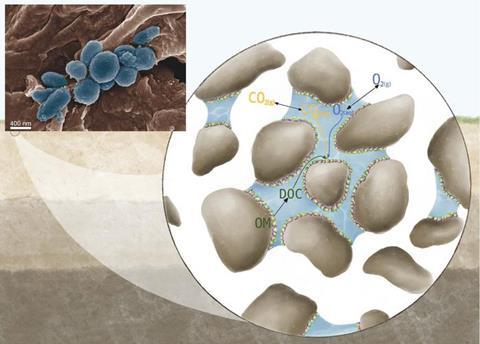Emissions of CO2 by soil microbes into the Earth’s atmosphere are not only expected to increase but also accelerate on a global scale by the end of this century, a new study suggests.

The rise in atmospheric carbon dioxide (CO2) concentration is a primary catalyst for global warming, and an estimated one fifth of the atmospheric CO2 originates from soil sources.
This is partially attributed to the activity of microorganisms, including bacteria, fungi, and other microorganisms that decompose organic matter in the soil utilizing oxygen, such as deceased plant materials. During this process, CO2 is released into the atmosphere, a process known as heterotrophic soil respiration.
Based on a recent study published in the scientific journal Nature Communications, a team of researchers from ETH Zurich, the Swiss Federal Institute for Forest, Snow and Landscape Research WSL, the Swiss Federal Institute of Aquatic Science and Technology Eawag, and the University of Lausanne has reached a significant conclusion.
Escalating emissions
Using a projection, they find that by 2100, CO2 emissions from soil microbes will escalate, potentially reaching an increase of up to about forty percent globally, compared to the current levels, under the worst-case climate scenario.
“Thus, the projected rise in microbial CO2 emissions will further contribute to the aggravation of global warming, emphasising the urgent need to get more accurate estimates of the heterotrophic respiration rates,” says Alon Nissan, the main author of the study and an ETH Postdoctoral Fellow at the ETH Zurich Institute of Environmental Engineering.
These findings do not only confirm earlier studies but also provide more precise insights into the mechanisms and magnitude of heterotrophic soil respiration across different climatic zones. In contrast to other models that rely on numerous parameters, the novel mathematical model, developed by Alon Nissan, simplifies the estimation process by utilising only two crucial environmental factors: soil moisture and soil temperature.
Simplified parameters
The model represents a significant advancement as it encompasses all biophysically relevant levels, ranging from the micro-scales of soil structure and soil water distribution to plant communities like forests, entire ecosystems, climatic zones, and even the global scale.
Peter Molnar, a professor at the ETH Institute of Environmental Engineering, highlights the significance of this theoretical model which complements large Earth System models, stating: “The model allows for a more straightforward estimation of microbial respiration rates based on soil moisture and soil temperature. Moreover, it enhances our understanding of how heterotrophic respiration in diverse climate regions contributes to global warming.”

A key finding of the research collaboration led by Peter Molnar and Alon Nissan is that the increase in microbial CO2 emissions varies across climate zones.
Polar sensitivity
In cold polar regions, the foremost contributor to the increase is the decline in soil moisture rather than a significant rise in temperature, unlike in hot and temperate zones. Alon Nissan highlights the sensitivity of cold zones, stating: “Even a slight change in water content can lead to a substantial alteration in the respiration rate in the polar regions.”
Based on their calculations, under the worst-case climate scenario, microbial CO2 emissions in polar regions are projected to rise by ten per cent per decade by 2100, twice the rate anticipated for the rest of the world. This disparity can be attributed to the optimal conditions for heterotrophic respiration, which occur when soils are in a semi-saturated state, i.e. neither too dry nor too wet. These conditions prevail during soil thawing in polar regions.
On the other hand, soils in other climate zones, which are already relatively drier and prone to further desiccation, exhibit a comparatively smaller increase in microbial CO2 emissions. However, irrespective of the climate zone, the influence of temperature remains consistent: as soil temperature rises, so does the emission of microbial CO2.
Climate zones
As of 2021, most CO2 emissions from soil microbes are primarily originating from the warm regions of the Earth. Specifically, 67 per cent of these emissions come from the tropics, 23 per cent from the subtropics, 10 per cent from the temperate zones, and a mere 0.1 per cent from the arctic or polar regions.
Significantly, the researchers anticipate substantial growth in microbial CO2 emissions across all these regions compared to the levels observed in 2021. By the year 2100, their projections indicate an increase of 119 per cent in the polar regions, 38 per cent in the tropics, 40 per cent in the subtropics, and 48 per cent in the temperate zones.
Sink or source?
The carbon balance in soils, determining whether soils act as a carbon source or sink, hinges on the interplay between two crucial processes: photosynthesis, whereby plants assimilate CO2, and respiration, which releases CO2. Therefore, studying microbial CO2 emissions is essential for comprehending whether soils will store or release CO2 in the future.
“Due to climate change, the magnitude of these carbon fluxes—both the inflow through photosynthesis and the outflow through respiration—remains uncertain. However, this magnitude will impact the current role of soils as carbon sinks,” explains Alon Nissan.
In their ongoing study, the researchers have primarily focused on heterotrophic respiration. However, they have not yet investigated the CO2 emissions that plants release through autotrophic respiration. Further exploration of these factors will provide a more comprehensive understanding of the carbon dynamics within soil ecosystems.







No comments yet